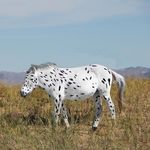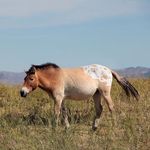Unsaddling old theory on origin of horses - CNRS
←
→
Page content transcription
If your browser does not render page correctly, please read the page content below
PRESS RELEASE l PARIS l 22 FEBRUARY 2018
Unsaddling old theory on origin of horses
Botai horses were tamed in Kazakhstan 5,500 years ago and thought to be the ancestors of
today’s domesticated horses . . . until a team led by researchers from the CNRS and
Université Toulouse III–Paul Sabatier sequenced their genome. Their findings published on
22 February 2018 in Science are startling: these equids are the progenitors not of the modern
domesticated horse, but rather of Przewalski’s horses—previously presumed wild!
The earliest proof of equine domestication points to the steppes of Central Asia roughly 5,500 years ago.
Current models suggest that all modern domesticated horses living now descend from those first tamed in
Botai, in the north of present-day Kazakhstan. For CNRS scientist Ludovic Orlando—from the Anthropologie
Moléculaire et Imagerie de Synthèse research lab (CNRS / Université Toulouse III – Paul Sabatier / Paris
Descartes University)—and his team, sequencing the genomes of 20 of these horses provided a snapshot
of biological evolution associated with domestication. Indeed, it is nearly impossible to uncover the earliest
stages of domestication through analysis of modern horse genomes, which have been considerably
transformed by humans through selective horse breeding.1
Yet this genomic analysis yielded unexpected results. Though Botai horses did not give rise to today’s
domesticated horses, they turn out to be direct ancestors of Przewalski’s horses. Thus the latter, commonly
thought to be the last wild horses on our planet, are actually the feral descendants of the first horses ever to
have been domesticated. The study highlighted certain changes that occurred with this return to a wild state,
including the loss of leopard spotting characteristic of the Botai horse. The allele responsible for this
coloration was probably eliminated by natural selection as it also caused night blindness.
The team’s genomic analysis of twenty-two Eurasian horses, whose lives collectively span the last 4,100
years, has revealed that none are related to the Botai horse. So the origin of modern domestic horses must
be sought elsewhere. The researchers are now focusing on other candidate locations in Central Asia as well
as on the Pontic-Caspian steppe of southern Russia, in Anatolia, and at various European sites that are
refuges for these animals.
This work was funded by the ERC (PEGASUS #681605), Villum Fonden (miGENEPI), the Danish Council
for Independent Research–Natural Sciences (4002-00152B), and Toulouse University’s IDEX Chaires
d’Attractivité program (OURASI). It brought together 47 researchers from 28 institutions.2
1. In a recent study, Orlando’s team reconstructed the genomes of Scythian horses and clearly demonstrated that they had been drastically
modified over the last 2,000 years. See http://www2.cnrs.fr/en/2917.htm
2. The participating entities in France were the Anthropologie Moléculaire et Imagerie de Synthèse (CNRS / Université Toulouse III–Paul Sabatier /
Paris Descartes University), Archéologies et Sciences de l'Antiquité (CNRS / University Paris Nanterre / Université Paris 1 Panthéon-Sorbonne /
French Ministry of Culture), and Archéozoologie et Archéobotanique (CNRS / MNHN) research units.Przewalski’s horses, Seer reintroduction reserve, Modern domestic horse herd in northern Kazakhstan, 2016.
Mongolia. © Alan Outram / University of Exeter
© Ludovic Orlando / Natural History Museum of Denmark / CNRS
Ludovic Orlando sampling the remains of Botai horses,
Kazakhstan, August 2016.
© Daron Donahue & Niobe Thompson. Clearwater documentary.
Excavation at the Botai site, Northern Kazakhstan, 2017.
© Alan Outram / University of Exeter
Artistic reconstruction of Botai horses based on
genetic evidence.
Some of the Botai horses were found to carry genetic
variants causing white and leopard coat spotting
patterns.
© Photograph by Ludovic Orlando, reworked by Sean
Goddard and Alan Outram.
Other pictures are available upon request (veronique.etienne@cnrs.fr).Reference Ancient genomes revisit the ancestry of domestic and Przewalski’s horses, Charleen Gaunitz, Antoine Fages, Kristian Hanghøj, Anders Albrechtsen, Naveed Khan, Mikkel Schubert, Andaine Seguin-Orlando, Ivy J. Owens, Sabine Felkel, Olivier Bignon-Lau, Peter de Barros Damgaard, Alissa Mittnik, Azadeh Mohaseb, Hossein Davoudi, Saleh Alquraishi, Ahmed H. Alfarhan, Khaled A. S. Al-Rasheid, Eric Crubézy, Norbert Benecke, Sandra Olsen, Dorcas Brown, David Anthony, Ken Massy, Vladimir Pitulko, Aleksei Kasparov, Gottfried Brem, Michael Hofreiter, Gulmira Mukhtarova, Nurbol Baimukhanov, Lembi Lõugas, Vedat Onar, Philipp W. Stockhammer, Johannes Krause, Bazartseren Boldgiv, Sainbileg Undrakhbold, Diimaajav Erdenebaatar, Sébastien Lepetz, Marjan Mashkour, Arne Ludwig, Barbara Wallner, Victor Merz, Ilja Merz, Viktor Zaibert, Eske Willerslev, Pablo Librado, Alan K. Outram, Ludovic Orlando. Science, 22 February 2018. Contacts CNRS scientist l Ludovic Orlando l ludovic.orlando@univ-tlse3.fr CNRS press officer l Véronique Etienne l T +33 (0)1 44 96 51 37 l veronique.etienne@cnrs.fr
You can also read
























































